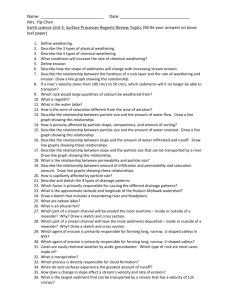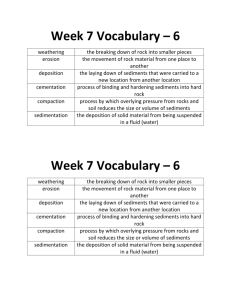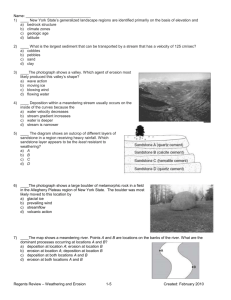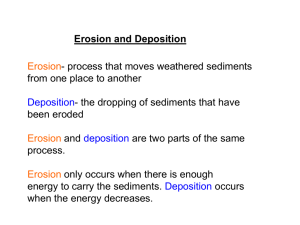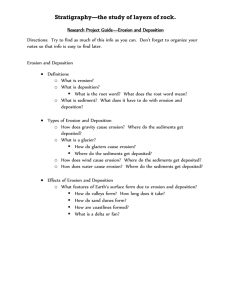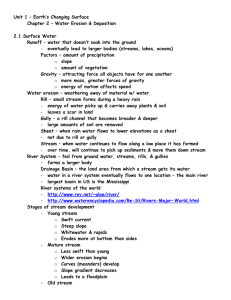Review Worksheet On Erosion Weathering And Deposition
advertisement
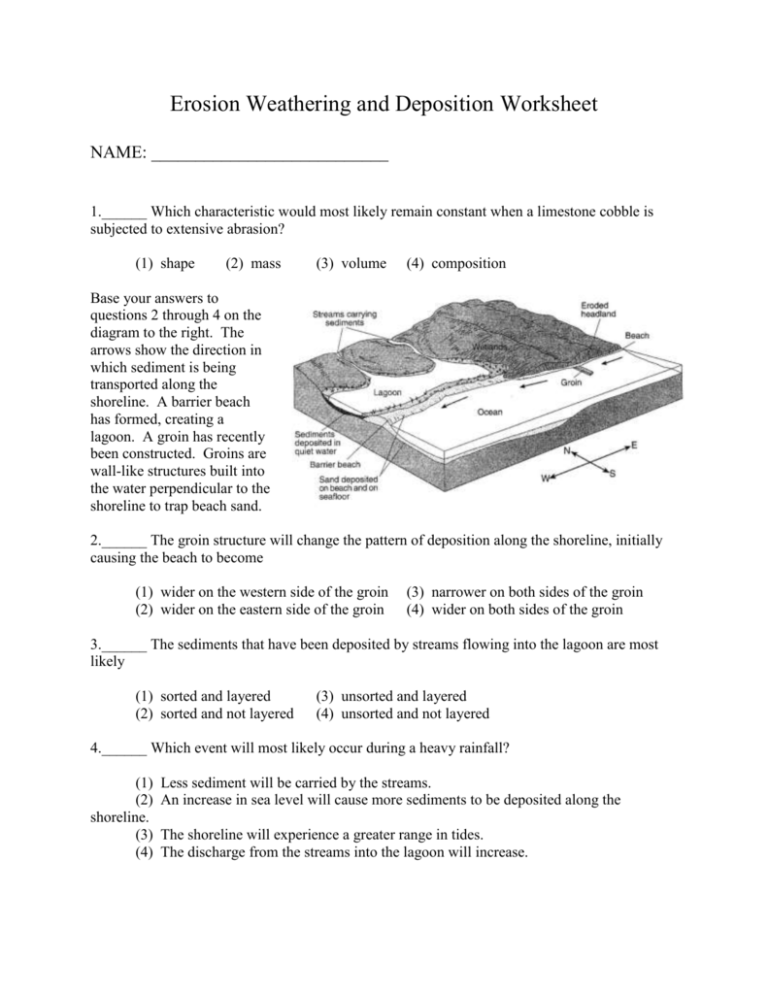
Erosion Weathering and Deposition Worksheet NAME: ___________________________ 1.______ Which characteristic would most likely remain constant when a limestone cobble is subjected to extensive abrasion? (1) shape (2) mass (3) volume (4) composition Base your answers to questions 2 through 4 on the diagram to the right. The arrows show the direction in which sediment is being transported along the shoreline. A barrier beach has formed, creating a lagoon. A groin has recently been constructed. Groins are wall-like structures built into the water perpendicular to the shoreline to trap beach sand. 2.______ The groin structure will change the pattern of deposition along the shoreline, initially causing the beach to become (1) wider on the western side of the groin (2) wider on the eastern side of the groin (3) narrower on both sides of the groin (4) wider on both sides of the groin 3.______ The sediments that have been deposited by streams flowing into the lagoon are most likely (1) sorted and layered (2) sorted and not layered (3) unsorted and layered (4) unsorted and not layered 4.______ Which event will most likely occur during a heavy rainfall? (1) (2) shoreline. (3) (4) Less sediment will be carried by the streams. An increase in sea level will cause more sediments to be deposited along the The shoreline will experience a greater range in tides. The discharge from the streams into the lagoon will increase. 5.______ The entire are drained by a river and its tributaries is called a (1) delta (2) watershed (3) valley (4) floodplain 6.______ Which event is an example of chemical weathering? (1) (2) (3) (4) rocks falling off the face of a steep cliff feldspar in granite being crushed into clay-sized particles water freezing in cracks in a roadside outcrop acid rain reacting with limestone bedrock 7.______ Which natural agent of erosion is mainly responsible for the formation of the barrier islands along the southern coast of Long Island, New York? (1) mass movement (2) running water (3) prevailing winds (4) ocean waves 8.______ Which profile best shows the general depositional pattern that occurs when water from a stream enters the ocean. 9. What characteristic of the stream changes to cause the deposition to occur? 10. If a glacier completely melted, what two pieces of evidence could a scientist find that a glacier had existed in this area? 11.______ Which graph to the right best represents the relationship between the slope of a river and the particle size that can be transported by that river? 12.______ Which agent of erosion was primarily responsible for forming the long, narrow, Ushaped valleys in the Finger Lakes region of New York State? (1) wind (2) landslides (3) meandering streams (4) continental glaciers The diagram to the right shows the surface features of a landscape. 13.______ Based on the features shown, which erosional agent had the greatest effect on tree growth and the structures that humans have built on this landscape? (1) running water (2) moving ice (3) prevailing wind (4) mass movement The diagram to the right shows some features in a cave. 14.______ What type of rock was chemically weathered by acidic groundwater to produce the cave and its features? (1) siltstone (2) basalt (3) quartzite (4) limestone Base your answers to questions 15 and 16 on the data table to the right, which shows the diameters of three particles A, B and C, made of the same uniform material. These particles were carried by a stream into a a lake. 15. The cross-sectional diagram to the right show the stream entering the lake. On the diagram, indicate the expected pattern of deposition of the three particles by placing the letters A, B, and C in the appropriate boxes along the lake bottom. 16. Explain why the particles are deposited after the stream enters the lake. 17.______ Which graph below best represents the relationship between the discharge of a stream and the velocity of stream flow? The diagrams to the right represent four different examples of one process that transports sediments. 18.______ Which process is shown in these diagrams> (1) chemical weathering (2) wind action (3) mass movement (4) rock abrasion The cross section to the right shows a stream flowing downhill. Points A through D are locations in the stream. 19.______ At which point would most deposition occur? (1) A (2) B (3) C (4) D Base your answers to questions 20 through 23 on the map of Long Island, New York. AB, CD, EF, and GH are reference lines on the map. 20.______ Which agent of erosion transported the sediments that formed the moraines on the map? (1) water (2) wind (3) ice (4) mass movement The cross section to the right represents the sediments beneath the land surface along one of the reference lines shown on the map. 21.______ Along which reference line was the cross section taken? (1) AB (2) CD (3) EF (4) GH 22.______ A major difference between sediments in the outwash and sediments in the moraines is that the sediments deposited in the outwash are (1) larger (2) sorted (3) more angular (4) older Base your answer to questions 23 through 25 on the cross section to the right, which shows limestone bedrock with caves. 23. In the margin to the right of the cross section, draw a line to indicate the level of the water table. 24. The precipitation in this area is becoming more acidic. Explain why acid rain weathers limestone bedrock. 25. Identify one source of pollution caused by human activity that contributes to the precipitation becoming more acidic. The map to the right shows the stream drainage pattern for a region of Earth’s surface. Points A, B, C and D are locations in the region. A 26.______ The highest elevation on the map most likely exists at point (1) A (2) B (3) C (4) D 27.______ Outwash plains are formed as a result of deposition by (1) landslide (2) ocean waves (3) winds from hurricanes (4) meltwater from glaciers 28.______ Which New York State river flows generally southward? (1) St. Lawrence River (2) Niagara River (3) Genesee River (4) Hudson River The cross section to the right shows a soil profile 29.______ The soil was formed primarily by (1) erosion by glaciers (3) capillarity and human activity (2) erosion by running water (4) weathering and biological activity The diagram to the right shows four magnified, block-shaped sandstone samples labeled A, B, C and D. Each sandstone sample contains quartz grains of different shapes and sizes. The quartz grains are held together by hematite cement. 30.______ In which sample did the quartz grains undergo the most abrasion during erosional transport? (1) A (2) b (3) C (4) D Base your answers to questions 31 through 33 on the map to the right, which shows the drainage basin of the Mississippi River system. Several rivers that flow into the Mississippi River are labeled. The arrow at location X shows where the Mississippi River enters the Gulf of Mexico. 31.______ The entire land area drained by the Mississippi River is referred to as a (1) levee (2) watershed (3) meander belt (4) flood plain 32.______ Sediments deposited at location X by the Mississippi River most likely have which characteristics? (1) angular fragments arranged as mixtures (2) rock particles arranged in sorted beds (3) rocks with parallel scratches and grooves (4) high density minerals with hexagonal crystals 33.______ The structure formed by the deposition of sediments at location X is best described as a (1) moraine (2) tributary (3) delta (4) drumlin


